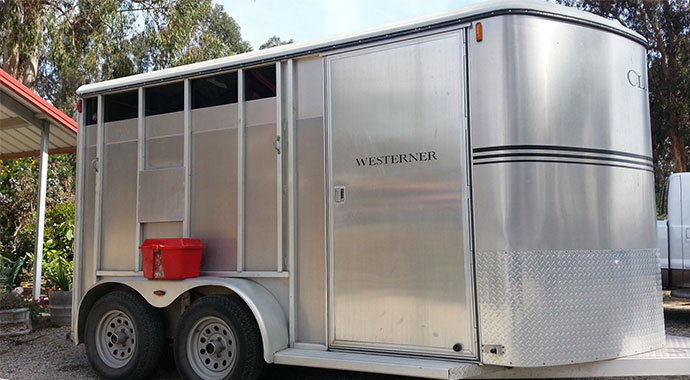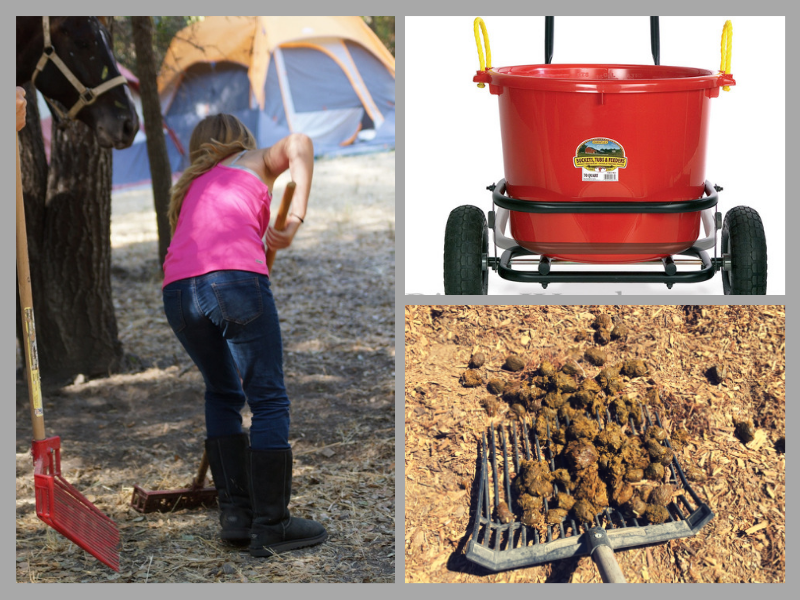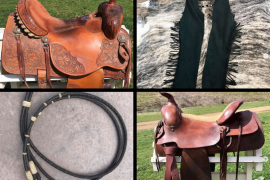Winter is finally coming to an end, which means that we’re all thinking about doing more riding! Whether you are preparing for the spring and summer show season, or simply dusting off your trail riding gear, one thing is for certain, you will likely be spending more time pulling your horse trailer. While getting out onto the road with your truck and trailer is necessary for most of your fantastic adventures, it is also a serious matter. In order to keep your “precious cargo” safe and secure, it is your job to be well informed and properly prepared for whatever comes your way.
Yearly Trailer Check
Everything begins with the safety of your rig; If you don’t keep your trailer in good working condition, no amount of emergency preparation is going to help you avoid a problem. As your trailer often sits idle for most of the winter,
It’s a good idea to choose a month in early spring (prior to your first major haul) to designate as ‘trailer maintenance month’.
The first step is to have an all over check performed by someone who is familiar with horse trailers, either a professional, or you can do it yourself if you know what you are looking for. Pay close attention to the underside of the trailer (which we don’t often bother to check) and the floor, which after becoming soaked with urine and other road debris, can be weakened over time. Go through your electrical system and make sure that all of your lights (brakes, turn signals, hazards, and running lights) are working properly, as well as your trailer brake system if equipped. Check your hitch connections and chains, your windows and your rear trailer doors and/or ramps, and apply lubrication to all of the moving parts. Look for any rust or other areas of concern (if you find any, address them immediately). Finally, check your tire tread and pressure, tighten lugs if needed, and make sure that your wheel bearings are properly packed.
The second step is to do a good trailer cleaning. By completely removing all of the shavings and/or hay inside of the trailer, you will be able to use a pressure washer (either at home or at the car wash) to get rid of all the dirt and debris that if left sitting for too long can effect your flooring and the trailer itself. Make sure to wash the roof of the trailer and check all of the weather stripping, which can become brittle or cracked. Don’t forget to check through your tack room or storage compartments and do a complete cleaning there as well; You will thank yourself the first time you pack up to go on an adventure and have a clean space to deal with.
Emergency Medical Kit
We all hope that nothing ever goes wrong while we are out on the road with our horses, but there is always the possibility that physical injury can happen. An “Emergency Medical Kit” is imperative for anyone who travels with their horse.
First get a nice box; I like one that has a sturdy handle and latch, so that it can be easily grabbed and carried if necessary. A small toolbox is usually a good call, and they are fairly inexpensive. Now it’s time to stock your box. There are three main areas to cover: oral medications, topical wound dressings, and wraps.
1. Oral Medications
When it comes to oral medications, there are four categories that you will want to address: Tranquilizers, pain medication, muscle relaxers and, electrolytes. Tranquilizers are important in the event that something catastrophic occurs (car accident, horse falling in the trailer, major injury out on the trail, etc.) that requires your horse to remain calm until emergency help arrives. Most effective tranquilizers only come in intravenous form because that is the delivery method that will get you the quickest results. “Dormosedan Gel” is the best product available for oral application, and it works rather quickly and effectively – about 20 minutes to begin taking effect. So, if you aren’t extremely comfortable giving intravenous medications, go with an oral tranquilizer. Bute Paste and Banamine Paste should cover you for pain medication and muscle relaxers (if you have a sudden colic, or an injury that you can either treat yourself, or that can wait until you get home to fully address). There are many types of electrolytes available; I usually go with the “Stress Pack” paste, because it can be quickly administered and does not require water immediately.
The majority of your oral medications will have to be purchased through your veterinarian. Most are happy to provide you with what you need for an emergency medical kit, as well as give you instructions as to how and when to administer the medications properly.
2. Topical Wound Dressings
It is much more likely that your emergency kit will get used for cuts, scrapes, and other minor issues, than major injuries or incidents, but it is good to be prepared for everything. First, you will want to have a good “blood stop” powder to quickly stop bleeding if a serious laceration occurs. In most circumstances, applying this powder is enough to treat something quickly and effectively. Additionally, it is a good idea to have a microbial wash (Betadine works well), topical antibiotic ointment (Nitrofurazone is a good choice), a general wound treatment (Corona ointment is usually the most common choice), and an equine “eye wash”. I also keep a bottle of “Well-Horse” wound treatment in my Emergency Kit; This is a product created by a Central Coast resident, and it works well on everything from skin fungus and minor scrapes, to major lacerations and more serious wounds. I like the product because it goes on in a liquid form, but quickly dries to a powder, which stays in place and doesn’t attract dirt. Best of all, it’s all natural and very safe.
3. Wraps
This portion of your emergency kit can be quickly and easily addressed with Vet Wrap, gauze wrap, sterilized gauze pads, several clean rags, and a clean set of either No-Bow or Pillow Wraps with standing wrap bandages. Make sure that you ask your veterinarian, trainer or someone who is experienced, to give you a crash course on “field wrapping” a lower leg injury and properly applying a standing wrap. Additionally, I include several pairs of clean cotton socks in my emergency kit — cut the toes off and pull them over the hoof so that the heel rests beneath the fetlock and you have the perfect quick covering for any minor injury.
Add a pair of scissors, a stethoscope, and a thermometer to the above, and you will have a pretty complete emergency medical kit. Remember to restock your kit if you use anything while out on the road, and remember that some of the medications you have in your kit will have expiration dates, so be mindful.
Finally, make sure that you carry at least five gallons of clean, drinkable water with you in your horse trailer (you can either purchase a trailer water tank, which comes in very handy at shows, while horse camping, etc., or you can fill a Sparklets type water bottle). Having access to water is important in the event that you have a breakdown on the road and are stuck for an extended period of time, and it can also come in handy for washing wounds, cooling down an overheating horse, or even in the event that your truck needs water or you yourself do.
In the end, preparation and equipment in good working order are the keys to safe travels with your horse. If you take the time before you leave the barn to think of the things that “might” happen, you will thank yourself in the event that they do.
[contentblock id=4]



